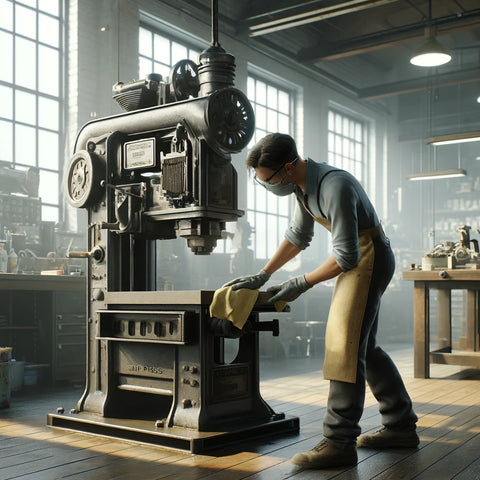In the heart of every workshop, the shop press operates as a cornerstone tool, essential for a broad spectrum of tasks from metal forming to assembly work. Despite its robust design, the shop press is not immune to issues. Understanding these potential problems and knowing how to effectively address them can significantly reduce downtime and maintain the safety and productivity of your workspace.
This detailed guide explores the nuances of common shop press problems, providing practical solutions and indispensable maintenance tips to keep your press running smoothly.
Identifying Common Shop Press Problems

Shop presses are indispensable in many workshops, but like all machinery, they're prone to issues. Recognizing these problems is the first step in maintaining a productive and safe working environment.
Hydraulic System Failures
These include leaks, pressure loss, and faulty seals, which can significantly impact the performance of hydraulic shop presses.
Mechanical Malfunctions
Problems with frames, alignment, or moving parts can arise, affecting the press's ability to function properly.
Electrical Issues
For electrically powered presses, common faults include issues with wiring, fuses, or switches that may hinder operation.
Understanding the types of issues that can affect your shop press is crucial for maintaining a safe and efficient workspace. By recognizing the signs of hydraulic system failures, mechanical malfunctions, and electrical issues, you're better prepared to address problems quickly and effectively.
Troubleshooting Guide

When faced with operational challenges in using a shop press, knowing how to identify and address common issues can make all the difference.
1. Hydraulic System Failures
- Symptom: Loss of Pressure
- Potential Causes: Leaks in the system or low hydraulic fluid levels can lead to reduced performance.
- Solutions: Conduct a thorough check for leaks and repair any found. Ensure the hydraulic fluid is refilled to the recommended level.
- Symptom: Faulty Seals
- Potential Causes: Regular wear and tear over time.
- Solutions: Inspect seals regularly and replace any that are worn to prevent leaks and maintain optimal pressure.
2. Mechanical Malfunctions
- Symptom: Misalignment or Uneven Pressing
- Potential Causes: Warped frames or improper setup.
- Solutions: Verify the integrity of the frame and ensure the setup is correct and aligned for each job.
- Symptom: Difficulty in Moving Parts
- Potential Causes: Insufficient lubrication or the accumulation of debris.
- Solutions: Implement a routine cleaning and lubrication schedule for all moving parts to ensure smooth operation.
3. Electrical Issues (For Electric Presses)
- Symptom: Press Not Starting or Operating Intermittently
- Potential Causes: Issues could stem from faulty wiring, blown fuses, or defective switches.
- Solutions: Inspect the electrical components carefully and replace any that are not functioning correctly to restore operation.
It's clear that understanding your shop press, recognizing common issues, and knowing how to address them are crucial for maintaining a productive and safe workshop environment. By applying the practical solutions, you can ensure your shop press continues to operate efficiently, minimizing downtime and maximizing your workshop’s output.
Maintenance Tips for Keeping Your Shop Press in Top Condition

Maintaining your shop press is essential not only for its performance but also for workshop safety. Here are streamlined tips to help ensure your shop press remains reliable and efficient:
Regular Checks on the Hydraulic System: The lifeblood of any hydraulic press is its fluid. Keep an eye on the fluid level, ensuring it's always at the optimal mark. Also, be vigilant about the fluid's condition; change it according to the manufacturer's schedule to ward off contamination and system degradation.
Prioritize Cleanliness: A clean shop press is more than just an aesthetic choice; it's a functional necessity. Dust, debris, and residual materials can cause jams and affect the press's operation. Regular cleaning, particularly of the ram and work area, prevents buildup and preserves the machinery's integrity.
Stay on Top of Inspections: Regular, detailed inspections can catch early signs of wear or damage, especially to critical areas like hydraulic hoses, seals, and the pressing mechanism itself. Promptly addressing these signs can prevent minor issues from escalating into major malfunctions.
Adhering to these maintenance tips will not only extend the lifespan of your shop press but also enhance its performance and safety. A well-maintained shop press is a reliable asset in any workshop, ready to tackle projects with precision and efficiency. To keep your shop press in good condition, stay proactive. This will help extend its lifespan and ensure high productivity and safety in your workshop.
Don't miss out on our selection of top-quality shop presses designed to meet the diverse needs of modern workshops. Whether you're upgrading your current equipment or selecting your first press, we have the models and expertise to help you make the best choice. Check out our shop presses today and elevate your workshop's capabilities to the next level.
Keep pushing the boundaries of what you can achieve, and let your shop press be the reliable partner it's meant to be in all your workshop projects.

